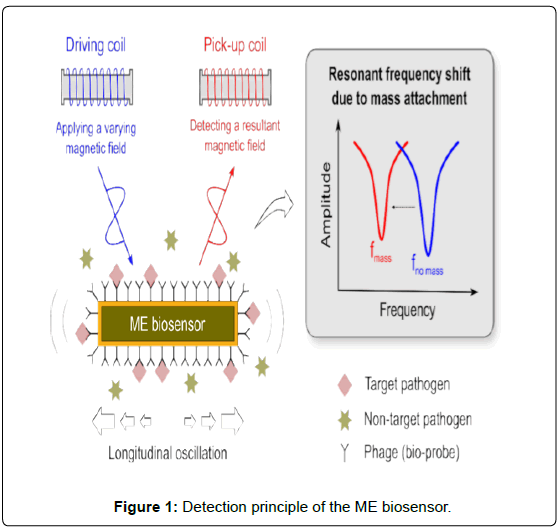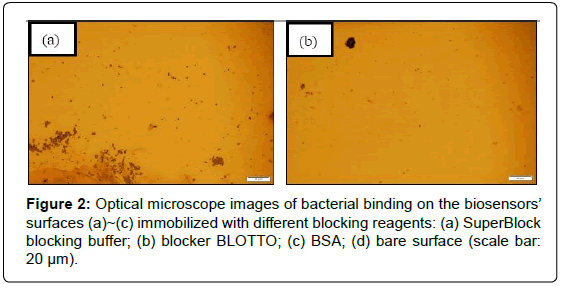Short Communication Open Access
Blocking Non-Specific Binding for Phage-Based Magnetoelastic Biosensors
Jia-Jia Hu1,2, Yating Chai2, Shin Horikawa2, Bryan A Chin2 and Jing Hu1,2*
1School of Materials Science and Engineering, Changzhou University, Changzhou 213164, China
2Materials Research and Education center, Auburn University, AL 36849, USA
- Corresponding Author:
- Hu J
School of Materials Science and Engineering
Changzhou University
Changzhou 213164, China
Tel: +0086-519-86330065
Fax: +0086-519-85212419
E-mail: jinghoo@126.com
Received Date: September 04, 2015; Accepted Date: October 31, 2015; Published Date: November 02, 2015
Citation: Hu JJ, Chai Y, Horikawa S, Chin BA, Hu J (2015) Blocking Non-Specific Binding for Phage-Based Magnetoelastic Biosensors. Biosens J 4:130.doi:10.4172/2090-4967.1000130
Copyright: © 2015 Hu JJ, et al. This is an open-access article distributed under the terms of the Creative Commons Attribution License, which permits unrestricted use, distribution, and reproduction in any medium, provided the original author and source are credited.
Visit for more related articles at Biosensors Journal
Abstract
The magnetoelastic (ME) biosensors are used to detect pathogen in fresh juice or milk by solenoid coil, and also developed for real-time, direct pathogen detection on food surfaces by surface-scanning coil. This paper presents blocking effect of different reagents on non-specific binding for detecting Salmonella typhimurium in apple juice using phage-based magnetoelastic biosensors. Three different blocking reagents of Bovine serum albumin, Superblock blocking buffer and blocker BLOTTO were used and evaluated. The results shows that blocker BLOTTO has the best blocking effect on non-specific binding.
Keywords
Biosensors; Blocking; Salmonella typhimurium; Nonspecific; Phage
Introduction
A biosensor essentially consists of two main components, a physical transducer and a biorecognition element. In this study, a magnetostrictive platform was served as the transducer, since it offers wireless or remote detecting, which is a unique advantage over conventional sensor platforms. E2 phage specific to Salmonella typhimurium (5 × 108 CFU/mL) was selected as the biorecognition element, and the sensors were immersed in the phage suspension for 1 hour to achieve uniform physical immobilization on the surfaces. The detecting principle is illustrated in Figure 1.
As shown in Figure 1, the sensor exhibits a physical resonance with specific frequency when it undergoes a time-varying magnetic field due to its magnetoelastic nature of the amorphous magnetostrictive alloy. Upon the attachment of the target pathogen, the mass of the biosensor increases, thereby its resonant frequency decreases. In other words, a shift in resonance frequency of the magnetostrictive sensor occurs when its mass changes, and the frequency shift depends only on the mass change when testing environmental parameters are invariable [1-3].
If the mass increase is small compared to the initial mass of the biosensor, the shift in the resonant frequency is given by Liang et al., and Guntupalli et al., [4,5]:
Where M is the initial mass, Δm is the mass change, and Δf is the shift in the resonant frequency of the sensor.
According to the shift in the resonance frequency due to the specific binding of Salmonella typhimurium, the concentration of the target bacteria in the detected environment can be evaluated.
However, it was found that it is impossible for E2 phage to cover 100% of the ME biosensor surface in real application [6,7]. The blank area of the biosensor surface, where no E2 phage is covered, has a tendency to bind other food components, such as proteins, salts or fat in the media. These non-specific bindings will also cause mass increase of the sensors, thus also result in a decrease in resonant frequency, which will bring out the measurement error and adversely affect the detection sensitivity. Therefore, in order to minimize or avoid the non-specific binding, it is necessary to block the blank area of the biosensor surface. The goal of this research is to evaluate the blocking effect of different kinds of reagents, thus, control sensors without phage immobilization were prepared and adopted, which means there is no specific binding of Salmonella typhimurium on the control sensors’ surfaces.
Three kinds of blocking reagents (Bovine serum albumin, Superblock blocking buffer, and blocker BLOTTO) were used and evaluated. The gold-coated sensors were immersed in different blocking reagents (about 330 μL in each tube) for 2 hours for uniform immobilization.
Figure 2 shows the optical microscope images of bacterial binding on the surface of control biosensors immobilized with or without blocking reagents. Comparing with the bare sensor (Figure 2d), those immobilized with different blocking reagents have much fewer bacterial cells bind on the surfaces. The results proved that the blocking reagents are able to effectively prevent non-specific bindings. Comparing the performance of the different blocking reagents, blocker BLOTTO has the best blocking ability for non-specific bindings (Figure 2b).
Acknowledgements
This project was supported by National Natural Science Foundation of China (51271039), USDA Grant 2011-51181-30642A and Jiangsu PAPD project in China.
References
- Petrenko VA, Sorokulova IB (2004) Detection of biological threats. A challenge for directed molecular evolution. J Microbiol Methods 58:147-168.
- Sorokulova IB, Olsen EV, Chen IH, Fiebor B, Barbaree JM, et al. (2005) Landscape phage probes for Salmonella typhimurium. J Microbiol Methods 63: 55-60.
- Guntupalli R, Hu J, Lakshmanan RS, Huang TS, Barbaree JM, et al. (2007) Amagnetoelastic resonance biosensor immobilized with polyclonal antibody for the detection of Salmonella typhimurium. BiosensBioelectron 22: 1474-1479
- Liang C, Morshed S, Prorok BC (2007) Correction for longitudinal mode vibration in thin slender beams. ApplPhysLett 90: 221912.
- Guntupalli R, Lakshmanan RS, Wan J, Kim DJ, Huang TS, et al. (2008) Analytical performance and characterization of antibody immobilized magnetoelastic biosensors. SensInstrum Food Qual 2: 27-33.
- Dadarwal R, Namvar A, Thomas DF, Hallc JC, Warriner K (2009) Organic conducting polymer electrode based sensors for detection of Salmonella infecting bacteriophages. Mater SciEng C 29:761-765.
- Ye XM, Guntupalli R, Chin BA, Lakshmanan RS, Hu J (2014) Comparative study of thermal stability of magnetostrictive biosensors between two kinds of biorecognition elements. Mater SciEng C 41: 78-82.
Relevant Topics
- Amperometric Biosensors
- Biomedical Sensor
- Bioreceptors
- Biosensors Application
- Biosensors Companies and Market Analysis
- Biotransducer
- Chemical Sensors
- Colorimetric Biosensors
- DNA Biosensors
- Electrochemical Biosensors
- Glucose Biosensors
- Graphene Biosensors
- Imaging Sensors
- Microbial Biosensors
- Nucleic Acid Interactions
- Optical Biosensor
- Piezo Electric Sensor
- Potentiometric Biosensors
- Surface Attachment of the Biological Elements
- Surface Plasmon Resonance
- Transducers
Recommended Journals
Article Tools
Article Usage
- Total views: 10920
- [From(publication date):
December-2015 - Apr 04, 2025] - Breakdown by view type
- HTML page views : 9901
- PDF downloads : 1019


